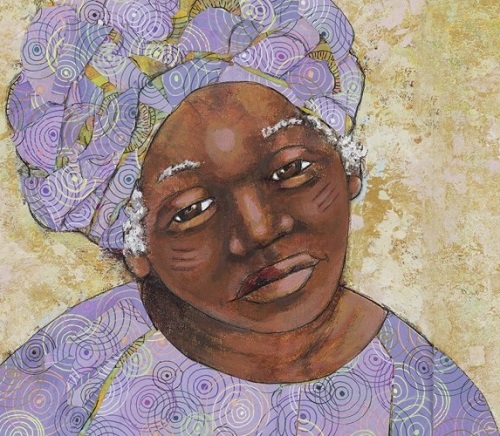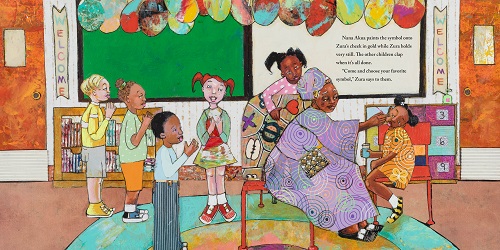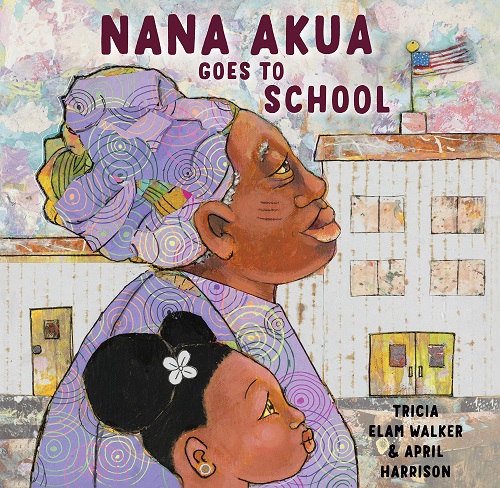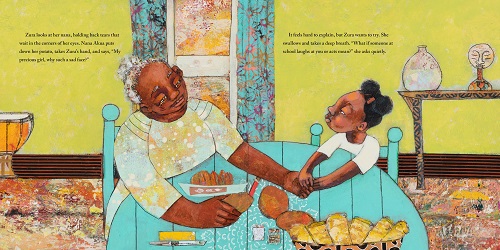Nana Akua Goes to School
 June 3rd, 2020 by jules
June 3rd, 2020 by jules
(Click spread to enlarge and read text in its entirety)
It’s Circle Time in Zura’s classroom when her teacher, Mr. Dawson, announces that soon the class will celebrate Grandparents Day, during which students’ grandparents will visit the classroom to share “what makes them special.” Zura is apprehensive, because though her Nana Akua is her “favorite person in the whole universe,” Nana Akua has facial markings that “never wash off and never go away.” Zura worries her beloved grandmother will be mocked when she visits the classroom.
The facial markings are an African tradition, designating Nana Akua’s tribal family. Having grown up in Ghana and as she explains to Zura’s classmates on the day she visits …
“These marks were gifts from my parents, who were happy and proud that I was born. … I am likewise proud to wear them. Most Ghanaian parents don’t celebrate in this way anymore, but it was once an important tradition.”
This is the story of Tricia Elam Walker’s Nana Akua Goes to School (Schwartz & Wade, June 2020), illustrated by April Harrison. Nana Akua brings with her to the classroom a quilt that features Adinkra symbols, ones that appear on decorative items in many African countries, and — after she explains her facial markings to the curious crowd of students and adults — she lets the children choose a symbol from the quilt to be painted on their faces. (A series of these symbols and their meanings adorn the opening and closing endpapers.) Even the other visiting grandparents choose symbols and let Nana Akua paint their faces.
An appended glossary lists some of the words used in the book that may be unfamiliar to readers, such as “Ashanti,” “Akua” (a female Ghanaian name, meaning “born on Wednesday”), and “maame.” It even includes some words spoken by some of Zura’s classmates, such as “abuelo.” An author’s note on the title page spread explains how the story “pays homage to several Ashanti traditions” and how Walker first learned about Adinkra symbols and their meanings when, decades ago, she placed her children in African-centered schools.
This tender story captures one girl’s experiences in coming to understand her family’s cultural heritage and the pride to be found there, and in this way it tells the specific story of one family. It also manages to speak universal truths about learning to embrace what makes one (and one’s family) special. Walker’s text is sensitive and empathetic, and Harrison’s remarkably textured illustrations on a warmly colored palette vividly capture Zura’s home and classroom settings, particularly the abundant love she has for her Nana Akua. Harrison is also a fine artist, whose work appears in public and private collections across the country, and this is her second picture book. If you missed last year’s What Is Given from the Heart, head here.
Here are a couple more spreads so that you can see some of Harrison’s splendid collage art. …

(Click spread to enlarge slightly and read text in its entirety)

The other children clap when it’s all done. ‘Come and choose
your favorite symbol,’ Zura says to them.”
(Click spread to enlarge)

NANA AKUA GOES TO SCHOOL. Text copyright © 2020 by Tricia Elam Walker. Illustrations copyright © 2020 by April Harrison. Illustrations reproduced by permission of the publisher, Schwartz & Wade Books, New York.

